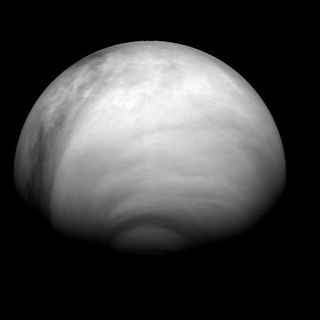Mysterious Haze Found on Venus

Brighthazes that mysteriously appear and then disappear on Venus in a matter of dayshave revealed a new dynamic feature of the planet?s cloudy atmosphere that isunlike anything on Earth.
The EuropeanSpace Agency's Venus Monitoring Camera (VMC) captured a series of imagesshowing the development of a bright haze over the southern latitudes of theplanet in July 2007. Over a period of days, the high-altitude veil continuallybrightened and dimmed, moving towards equatorial latitudes and then backtowards the south pole.
Thesetransient dark and bright markings indicate regions on the cloud-covered world wheresolar ultraviolet radiation is being absorbed and reflected by sulfuric acid particles,mission scientists said this week.
Gaseoussulfur dioxide and small amounts of water vapor are usually found belowaltitudes of about 43 miles (70 kilometers) in Venus' carbon-dioxide richatmosphere. These molecules are usually shrouded from view by cloudlayers above that block our view to the surface at visible wavelengths.
ESAscientists think the sulfuric acid particles that make up the bright haze arecreated when some atmospheric process lifts the gaseous sulfur dioxide andwater vapor high up above the cloud tops where they are exposed to ultravioletradiation from the sun.
The UVradiation breaks up the molecules, making them highly reactive. The fragmentsof the molecules eagerly seek each other out and combine to form the sulfuricacid particles.
"Theprocess is a bit similar to what happens with urban smog over cities,"said mission team member Dmitri Titov of the Max Planck Institute for SolarSystem Research in Germany.
Get the Space.com Newsletter
Breaking space news, the latest updates on rocket launches, skywatching events and more!
Exactlywhat causes the sulfur dioxide and water vapor to well up is not known, butTitov says it is likely some internal process of Venus'atmosphere.
The transientdark markings on the VMC images are even more of a mystery. They are caused bysomething that absorbs UV radiation, but scientists don't yet know what thechemical is.
- The Wildest Weather in the Galaxy
- Images: Beneath the Clouds of Venus
- All About Venus
Join our Space Forums to keep talking space on the latest missions, night sky and more! And if you have a news tip, correction or comment, let us know at: community@space.com.

Space.com is the premier source of space exploration, innovation and astronomy news, chronicling (and celebrating) humanity's ongoing expansion across the final frontier. Originally founded in 1999, Space.com is, and always has been, the passion of writers and editors who are space fans and also trained journalists. Our current news team consists of Editor-in-Chief Tariq Malik; Editor Hanneke Weitering, Senior Space Writer Mike Wall; Senior Writer Meghan Bartels; Senior Writer Chelsea Gohd, Senior Writer Tereza Pultarova and Staff Writer Alexander Cox, focusing on e-commerce. Senior Producer Steve Spaleta oversees our space videos, with Diana Whitcroft as our Social Media Editor.
Most Popular


